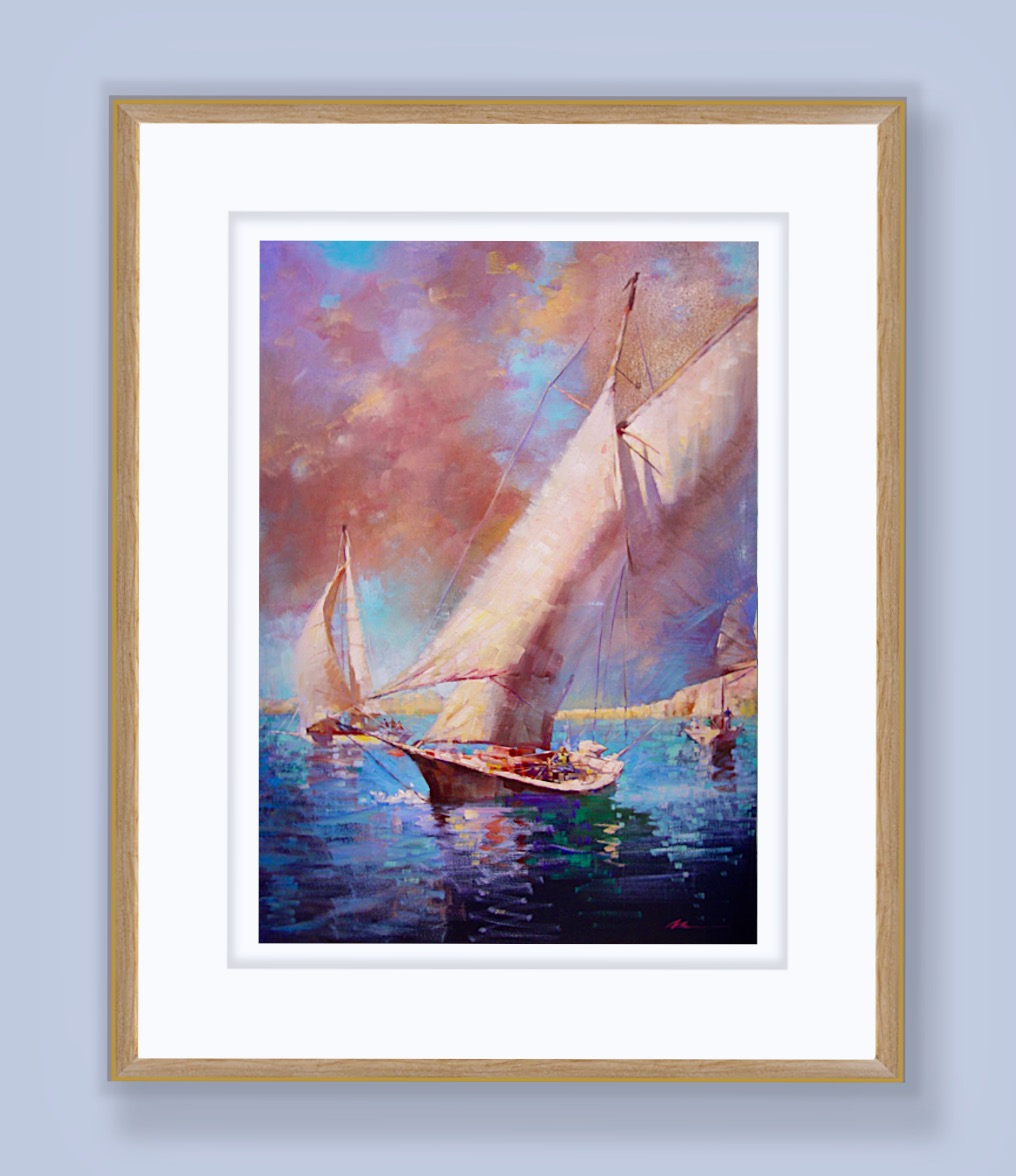

Title: Saturday Sailing Ocean Landscape Painting By Illustrator Jian Wu
Shipping: $29.00
Artist: N/A
Period: Contemporary
History: Art
Origin: North America > United States
Condition: Excellent
Item Date: May 2007
Item ID: 1550
Jian Wu, a graduate of the prestigious Art College of Qing Hua University (formerly Central Art and Crafts College of China) in 1984, has a remarkable artistic journey. Between his graduation and his emigration to the United States, Jian Wu undertook commissioned works for five-star hotels, and his pieces were showcased in China's National Art Exhibitions. In 1993, he pursued further studies at the Graduate School of the Academy of Art University in San Francisco, swiftly becoming a faculty member. His dedication and talent led to the attainment of a Master of Fine Art degree in 2000. As a seasoned professional artist, Jian has held solo exhibitions and participated in group shows across the United States, garnering awards in nationwide professional art exhibitions and competitions. In 2005, China Youth Press published his book, "Pastel Technique," showcasing his expertise in the medium. Additionally, his collection of oil paintings, titled "The Overseas Oil Painter of China Jian Wu," was published by Tianjin Peoples Fine Arts Publishing House in 2007. Jian Wu's works have found homes in collections throughout the United States and around the world.
The history of landscape painting is a rich and diverse journey that spans centuries and cultures. Here is a brief overview of the evolution of landscape painting: Ancient Art: Chinese Landscape Painting: Dating back to the 4th century, traditional Chinese landscape painting often featured mountains, rivers, and natural scenes, reflecting Taoist and Confucian philosophies. Greco-Roman Art: In ancient Greece and Rome, landscapes were often background elements in larger compositions rather than standalone works. They were used to set the stage for mythological or historical narratives. Medieval and Renaissance Europe: Miniature Landscapes: In medieval illuminated manuscripts, small landscape elements were incorporated, but the focus was primarily on religious or historical subjects. Renaissance Transition: During the Renaissance, artists like Leonardo da Vinci and Albrecht Dürer started to pay more attention to depicting nature accurately. However, landscapes were still subordinate to human figures. Dutch Golden Age (17th Century): Rise of Landscape Painting: Dutch artists, including Jacob van Ruisdael and Aelbert Cuyp, played a pivotal role in elevating landscape painting to a genre of its own. Scenes of the Dutch countryside, seascapes, and rural life became popular. 18th and 19th Century: Romanticism: The Romantic movement embraced nature as a source of inspiration. Artists like J.M.W. Turner and Caspar David Friedrich created emotionally charged landscapes, often with sublime and dramatic elements. Hudson River School: In the United States, the Hudson River School emerged, with artists such as Thomas Cole and Albert Bierstadt capturing the vast American landscapes. Manifest Destiny and exploration themes were prevalent. Impressionism and Beyond (Late 19th to Early 20th Century): Impressionist Landscapes: Artists like Claude Monet and Pierre-Auguste Renoir focused on capturing the effects of light and atmosphere in outdoor settings. The emphasis shifted from detailed realism to capturing the essence of a scene. Post-Impressionism: Artists like Vincent van Gogh and Paul Cézanne further pushed the boundaries of expression in landscapes, experimenting with color, form, and perspective. 20th Century to Present: Modernism and Abstraction: Landscape painting continued to evolve with movements like Cubism, Abstract Expressionism, and contemporary art. Artists explored new ways to represent and interpret the natural world. Environmental Art: In the latter half of the 20th century, artists engaged with environmental issues, using landscape as a medium to address ecological concerns. Throughout its history, landscape painting has reflected not only artistic trends but also cultural, philosophical, and environmental shifts, making it a dynamic and enduring genre in the world of art.
Link: http://en.wikipedia.org/wiki/Illustration
An illustration is a visualisation such as a drawing, painting, photograph or other work of art that stresses subject more than form. The aim of an illustration is to elucidate or decorate a story, poem or piece of textual information (such as a newspaper article), traditionally by providing a visual representation of something described in the text. The editorial cartoon, also known as a political cartoon, is an illustration containing a political or social message.